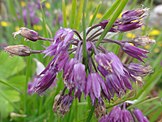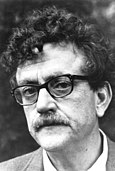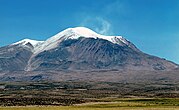Template:TFA archive
| << | Today's featured articles for April 2024 | >> | ||||
|---|---|---|---|---|---|---|
| Su | Mo | Tu | We | Th | Fr | Sa |
| 1 | 2 | 3 | 4 | 5 | 6 | |
| 7 | 8 | 9 | 10 | 11 | 12 | 13 |
| 14 | 15 | 16 | 17 | 18 | 19 | 20 |
| 21 | 22 | 23 | 24 | 25 | 26 | 27 |
| 28 | 29 | 30 | ||||
April 1

The Order of Brothelyngham was a gang of men who, in mid-14th-century England, formed themselves into a fake religious order in Exeter, Devon. Styling themselves as theatrical players, they terrorised, kidnapped and extorted the locals. They may well have been satirising the church, which was commonly perceived as corrupt. The group appears to have named itself after a non-existent place, "Brothelyngham". The name was probably meant as an allusion to the Order of Sempringham, which was known to enclose both monks and nuns on the same premises. Members of the Order of Brothelyngham dressed as monks. They supposedly elected a madman to rule them as their abbot, possibly from a theatrical stage, and bore their ruler aloft before them in a mockery of a bishop's throne. As one of the few such gangs known to modern historians, the order is considered significant for what it suggests of anticlerical activities and attitudes in England during the period. (Full article...)
April 2
Morgan Bulkeley (1837–1922) was an American politician and business executive from Connecticut, who was, in 1876, the first president of baseball's National League. A Civil War veteran and the son of the first president of the Aetna Life Insurance Company, Bulkeley also led Aetna, from 1879 until his death. A Republican, he was from 1880 to 1888 mayor of Hartford, and starting in 1889 served as governor of Connecticut. He controversially remained in office for a second two-year term because the houses of the state legislature could not agree about the outcome of the 1890 election. A Democratic official locked a door in the State Capitol against him, and Bulkeley had it opened with a crowbar, thus becoming "the Crowbar Governor". He left office in 1893, and served as a U.S. senator from 1905 to 1911. After his death in 1922, a bridge and a high school were named for him. His induction in 1937 into the Baseball Hall of Fame remains controversial because his involvement in the game was brief. (Full article...)
April 3
Daytona USA is an arcade racing game developed by Sega AM2 and published by Sega in March 1994. Inspired by the popularity of the NASCAR motor racing series in the US, the game has players race stock cars on one of three courses. It was the first arcade game to be released on the Sega Model 2, an arcade system board which was co-developed by GE Aerospace. AM2's Toshihiro Nagoshi (pictured) became the game's director and co-producer. Sega aimed to outperform Namco's Ridge Racer (1993). The developers researched motorsports extensively and mapped Daytona International Speedway. Daytona USA was a critical and commercial success, praised for its graphics, soundtrack and gameplay. A conversion was made for the Sega Saturn in 1995, and was followed by sequels and enhancements for consoles and arcades. Daytona USA is one of the highest-grossing arcade video games ever, and has been frequently named one of the best video games of all time. (Full article...)
April 4
Marshfield was a rapid transit station on the Chicago "L" in the U.S. between 1895 and 1954. Originally part of the Metropolitan West Side Elevated Railroad, it was the westernmost station of the Metropolitan's main line. West of the station, the main line diverged into three branches; this junction, served by the station, has been described as the most complex on the entire Chicago "L" system. After 1905, the Chicago Aurora and Elgin Railroad, an interurban line, also served the station, but limited its service based on direction to avoid competing with the "L". The lines that had been constructed by the Metropolitan, including those serving Marshfield, were subject to modifications planned since the 1930s that incrementally withdrew service from the station. It fully closed on April 4, 1954, and was demolished shortly thereafter. The junction Marshfield served was rebuilt in reduced form, but with a new station on Racine Avenue to the east. (Full article...)
April 5
The Hrabri class consisted of two submarines built for the Kingdom of Serbs, Croats and Slovenes. The first submarines to serve in the Royal Yugoslav Navy (KM), they arrived in Yugoslavia on 5 April 1928, and participated in cruises to Mediterranean ports prior to World War II. During the April 1941 Axis invasion of Yugoslavia, Hrabri (pictured) was captured by the Italians and later scrapped. Nebojša escaped to Egypt to join the British Royal Navy (RN). She served as an anti-submarine warfare training boat and then as a battery charging station. In May 1942 her crew were removed and placed in a British military camp following a revolt by Yugoslav generals in exile, and she received an almost entirely RN crew. She was briefly utilised for training at Beirut, but was formally handed back to the KM-in-exile in mid-1943. After the war, she was transferred to the new Yugoslav Navy and renamed Tara. She was used in a training role until 1954, then scrapped. (This article is part of a featured topic: Hrabri-class submarines.)
April 6
Appalachian Spring is an American ballet created by the composer Aaron Copland and the choreographer Martha Graham (pictured), later arranged as an orchestral work. Copland composed the ballet for Graham upon a commission from Elizabeth Sprague Coolidge. Set in a 19th-century settlement in Pennsylvania, the ballet follows the Bride and the Husbandman as they get married and celebrate with the community. The original choreography was by Graham, with costumes by Edythe Gilfond and sets by Isamu Noguchi. The ballet was well-received at the 1944 premiere, earning Copland the Pulitzer Prize for Music during its 1945 United States tour. The orchestral suite composed in 1945 was played that year by many symphony orchestras; the suite is among Copland's best-known works, and the ballet remains essential in the Martha Graham Dance Company repertoire. A film version of the original production was released in 1958 with Graham as the Bride; a similar recording was released in 1976 with Yuriko. (Full article...)
April 7
Edward Jones (7 April 1824 – c. 1895), also known as "the boy Jones", became notorious for breaking into Buckingham Palace in London several times between 1838 and 1841. He was first caught doing so when he was 14; although he was found with items he had stolen, he escaped a prison sentence. He broke into the palace again in December 1840, and was caught and sentenced to three months' hard labour. He was released in March 1841 and returned to the palace two weeks later, was arrested and served another three months. He was coerced into the Royal Navy by the Thames Police and served between 1842 and 1847. He was caught burgling houses in August 1849 and was transported to an Australian penal colony. He returned to England, was arrested for burglary in 1856 and served six months of hard labour. He probably died in Australia, either in Bairnsdale, Victoria, on Boxing Day 1893 or in Perth in 1896. (Full article...)
April 8

Bob Mann (April 8, 1924 – October 21, 2006) was an American professional football player in the National Football League (NFL) who broke the color barrier for both the Detroit Lions (alongside Mel Groomes) and the Green Bay Packers. He played college football at Hampton Institute in 1942 and 1943 and at the University of Michigan in 1944, 1946 and 1947. Playing the end position, he broke the Big Ten Conference record for receiving yards in 1946 and 1947. In 1948 Mann signed a professional contract with the Lions, where he stayed for two seasons. He led the NFL in receiving yards in 1949. After a brief stint with the New York Yanks he signed with the Packers, where he was the team's leading receiver in 1951. He remained with the Packers partway through the 1954 season. Mann later became a lawyer and practiced in Detroit. He was inducted into the Green Bay Packers Hall of Fame in 1988 and the Michigan Sports Hall of Fame in 2016. (Full article...)
April 9
The Mercury Seven were a group of American astronauts selected to fly spacecraft for Project Mercury. Announced by NASA on April 9, 1959, Scott Carpenter, Gordon Cooper, John Glenn, Gus Grissom, Wally Schirra, Alan Shepard, and Deke Slayton created a new profession. The group piloted all the spaceflights of the Mercury program that had an astronaut on board from May 1961 to May 1963, and some flew in the Gemini, Apollo, and Space Shuttle programs. Shepard became the first American to enter space in 1961, and walked on the Moon in 1971. Grissom, after flying Mercury and Gemini missions, died in 1967 in the Apollo 1 fire; the others survived past retirement from service. Schirra commanded Apollo 7, the first crewed Apollo flight. Slayton, grounded with atrial fibrillation, ultimately flew on the Apollo–Soyuz Test Project in 1975. Glenn became the first American in orbit in 1962, and flew on Space Shuttle Discovery in 1998 to become, at age 77, the oldest person to fly in space at the time. (Full article...)
April 10
The New South Wales waratah (Telopea speciosissima) is a large shrub in the family Proteaceae. Endemic to New South Wales, Australia, it is the floral emblem of that state. It grows as a shrub to 3–4 m (10–13 ft) high and 2 m (7 ft) wide, with dark green leaves and several stems rising from a pronounced woody base known as a lignotuber. During the spring it has striking large red flowerheads, each made up of hundreds of individual flowers. These are visited by the eastern pygmy possum (Cercartetus nanus), birds such as honeyeaters (Meliphagidae) and insects. T. speciosissima has featured prominently in art, architecture and advertising. No subspecies are recognised, but cultivars with various shades of red, pink and white flowers are commercially grown in several countries as a cut flower. The shrub can be difficult to cultivate in home gardens, requiring good drainage and being vulnerable to fungal disease and pests. (Full article...)
April 11
Kurt Vonnegut (1922–2007) was an American writer. In a career spanning over 50 years, he published fourteen novels and three short story collections; further works were published after his death. Born and raised in Indianapolis, Vonnegut enlisted in the U.S. Army in 1943. Deployed to Europe to fight in World War II, he was captured by the Germans and interned in Dresden, where he survived the Allied bombing of the city in a slaughterhouse. Vonnegut published his first novel, Player Piano, in 1952. Two of his novels, The Sirens of Titan (1959) and Cat's Cradle (1963), were nominated for the Hugo Award. Slaughterhouse-Five (1969), a best-seller that resonated with its readers for its anti-war sentiment amidst the ongoing Vietnam War, thrust Vonnegut into fame as an important contemporary writer and a dark humor commentator on American society. Numerous scholarly works have examined Vonnegut's writing and humor. (Full article...)
April 12
Fallout: A Post Nuclear Role Playing Game is a 1997 role-playing video game developed and published by Interplay Productions. Set in a post-apocalyptic world in the mid–22nd century, it revolves around the player character seeking a replacement computer chip for their underground nuclear shelter's water supply system. The gameplay involves interacting with other survivors and engaging in turn-based combat. Fallout started development in 1994 as a game engine designed by Tim Cain (pictured). It was originally based on GURPS, a role-playing game system, though the character-customization scheme was changed after the GURPS license was terminated. Fallout drew artistic inspiration from Atomic Age media and is considered a spiritual successor to Wasteland (1988). The game was a critical and commercial success and spawned a successful series of sequels and spin-offs. It has since been credited for renewing consumer interest in computer role-playing games. (Full article...)
April 13
The 1999 Sydney hailstorm was the costliest natural disaster in Australian history at the time as measured by insured damage. The storm developed south of Sydney, New South Wales, on the afternoon of 14 April 1999 and struck the city's central business district and its eastern suburbs later that evening. It dropped an estimated 500,000 tonnes of hailstones on Sydney and its suburbs. The insured damage bill was roughly A$1.7 billion, with the total bill (including uninsured damage) estimated to be around $2.3 billion. Lightning claimed one life, and the storm caused approximately 50 injuries. The storm was classified as a supercell following further analysis of its erratic nature and extreme attributes. The time of year and general conditions in the region were not seen as conducive for an extreme storm cell to form, and the Bureau of Meteorology was repeatedly surprised by its changes in direction, its duration, and the severity of the hail. (Full article...)
April 14
The American poet Walt Whitman spoke publicly many times on Abraham Lincoln, the 16th president of the United States. A series of at least eleven lectures on Lincoln's life and his assassination began in Steck Hall in New York City on April 14, 1879, and concluded in Philadelphia on April 14, 1890, two years before Whitman's death. They were generally well received, and cemented the poet's public image as an authority on Lincoln. Whitman greatly admired Lincoln and was moved by his assassination in 1865 to write several poems honoring him, including "O Captain! My Captain!", which Whitman recited during some of the talks. The lecture in 1887 at Madison Square Theatre in New York City is considered the most successful of the series, and was attended by many prominent members of American society. Whitman later described its reception as "the culminating hour" of his life. (This article is part of a featured topic: Walt Whitman and Abraham Lincoln.)
April 15
One of the Boys is an American sitcom created by Blake Hunter and Martin Cohan that aired six episodes on NBC from April 15 to May 20, 1989. It is one of only a few American primetime programs that decade to star a Latin American woman—María Conchita Alonso (pictured). She featured as Maria Conchita Navarro, a Venezuelan immigrant to the United States who begins working in the office of a small construction company and marries its widowed owner, Mike Lukowski (Robert Clohessy). Five production companies oversaw filming at Sunset Gower Studios in Hollywood, where delays prevented critics from watching a preview in advance of the premiere. Reviews referred to the concept as ordinary and a repeat of themes from other television shows at that time. Alonso's acting was mostly praised by critics. The mid-season replacement received inconsistent Nielsen ratings and was not renewed for a second season by NBC. (Full article...)
April 16

William T. Stearn (16 April 1911 – 9 May 2001) was a British botanist. Born in Cambridge, he was largely self-educated. He was head librarian at the Royal Horticultural Society's Lindley Library in London from 1933 to 1952, and then moved to the Natural History Museum where he was a scientific officer in the botany department until 1976. After retirement, he became the president of the Linnean Society and taught botany at Cambridge University. He is known for his work in botanical taxonomy, history, and illustration, and for his studies of the Swedish scientist Carl Linnaeus. Stearn is the author of Botanical Latin, as well as the Dictionary of Plant Names for Gardeners, a popular guide to the scientific names of plants. He is considered one of the most eminent British botanists of his time. An essay prize in his name from the Society for the History of Natural History is awarded each year. (Full article...)
April 17

Rumours is the 11th studio album by the British-American rock band Fleetwood Mac (pictured). Released in 1977 by Warner Bros. Records, it was produced by the band with Ken Caillat and Richard Dashut. Following the band's 1975 album Fleetwood Mac, Rumours includes a mix of electric and acoustic instrumentation, accented rhythms, guitars, and keyboards. The lyrics, written in the aftermath of several breakups among the band members, concern personal and often troubled relationships. Rumours became the band's first number-one album on the UK Albums Chart and topped the US Billboard 200, supported by the singles "Go Your Own Way", "Dreams", "Don't Stop", and "You Make Loving Fun". It sold more than 40 million copies worldwide and garnered widespread acclaim from critics, with praise centred on its production quality and vocal harmonies. In 2020, Rumours was ranked seventh in Rolling Stone's list of the "500 Greatest Albums of All Time". (Full article...)
April 18
Katana Zero is a 2019 platform game created by the indie developer Justin Stander. The player controls a katana-wielding assassin who can slow down time and predict the future, and must kill all enemies in a level without being hit. The story is told in sequences where the player converses with non-player characters through dialogue trees. Stander began working on Katana Zero in 2013 as his first commercial game. He sought to make a difficult story-driven game that minimized unskippable dialogue and cutscenes. He worked mostly alone during the prolonged development, although he recruited artists to design the visuals, and the musicians Bill Kiley and Thijs "LudoWic" Lodewijk to compose the synthwave soundtrack. Devolver Digital published Katana Zero for macOS, Nintendo Switch, and Windows on April 18, 2019. It sold 500,000 copies in less than a year and received positive reviews for its gameplay, visuals, writing, and music. Other ports are available, and downloadable content is in development. (Full article...)
April 19
Guallatiri is a stratovolcano in Chile that is 6,060–6,071 m (19,880–19,918 ft) high. It is located southwest of, or possibly within, the Nevados de Quimsachata volcanic group. The summit, surrounded by numerous fumaroles, may be a lava dome or volcanic plug, while the lower flanks of the volcano are covered by lava flows and lava domes. The volcano's eruptions have produced mostly dacite along with andesite and rhyolite. Past glaciation has left moraines on Guallatiri. A large eruption took place approximately 2,600 years ago. Guallatiri has been active since prehistoric times, with the latest known eruption in 1960. Fumarolic and seismic activity is ongoing and has resulted in the deposition of sulfur and other minerals on the volcano. It is covered by an ice cap above 5,500–5,800 m (18,000–19,000 ft) elevation that has retreated and broken up into separate ice bodies. Part of Lauca National Park, Guallatiri is monitored by the Chilean National Geology and Mining Service. (Full article...)
April 20
The Nicoll Highway collapsed in Singapore on 20 April 2004 when a Mass Rapid Transit tunnel construction site caved in, crumpling Nicoll Highway near the Merdeka Bridge. Four workers were killed and three were injured, delaying the construction of the Circle Line (CCL). The collapse was caused by a poorly designed strut-waler support system, a lack of monitoring and proper management of data caused by human error, and organisational failures of the construction contractors and the Land Transport Authority. Following the incident, the collapsed site was refilled, and Nicoll Highway was reinstated and reopened to traffic on 4 December 2004. The authorities revised their construction safety measures so they were above industry standards. The CCL tunnels were realigned, with Nicoll Highway station rebuilt underneath Republic Avenue, to the south of the original site. The station and tunnels opened on 17 April 2010, three years later than planned. (Full article...)
April 21
The 1984 World Snooker Championship was a ranking professional snooker tournament that took place between 21 April and 7 May at the Crucible Theatre in Sheffield, England. The event was organised by the World Professional Billiards and Snooker Association, and was the eighth consecutive World Snooker Championship to be held at the Crucible since the 1977 event. It featured 94 participants, of which 78 players competed in a qualifying event held at the Redwood Lodge in Bristol. The defending champion was English player Steve Davis (pictured), who had won the title twice previously. He met Jimmy White in the final, which was played as a best-of-35-frames match. Davis won 18–16, becoming the first player to retain the title at the Crucible. Rex Williams secured the championship's highest break, scoring a 138 in the 12th frame of his first-round loss to White. Eight century breaks were made during the competition, the fewest since the 1978 event. (Full article...)
April 22
Kathleen Ferrier (22 April 1912 – 8 October 1953) was an English contralto who achieved an international reputation as a stage, concert and recording artist. During the Second World War she performed regularly with the Council for the Encouragement of Music and the Arts. In 1946 she made her stage debut as Lucretia in the world premiere of Benjamin Britten's The Rape of Lucretia, and a year later she appeared as Orfeo in Christoph Willibald Gluck's Orfeo ed Euridice. As a recitalist, Ferrier's repetoire included works by Bach, Brahms, Mahler and Elgar. Forming working relationships with the conductors John Barbirolli and Bruno Walter and the accompanist Gerald Moore, she became known internationally through her three tours of the United States and her many visits to continental Europe. She continued to perform and record after being diagnosed with breast cancer in 1951. Among her many memorials, the Kathleen Ferrier Memorial Scholarship Fund makes annual awards to aspiring young singers. (Full article...)
April 23
Stanley Price Weir (23 April 1866 – 14 November 1944) was a public servant and Australian Army officer. During World War I, he commanded the 10th Battalion of the Australian Imperial Force during the landing at Anzac Cove and the Gallipoli campaign against the Ottoman Turks, and during the battles of Pozières and Mouquet Farm in France. Weir returned to Australia at his own request at the age of 50 in late 1916, when he was appointed as the first public service commissioner of South Australia. In 1917 he was awarded the Distinguished Service Order and was mentioned in despatches for his performance at Pozières and Mouquet Farm. On his retirement from the Australian Military Forces in 1921, he was given an honorary promotion to brigadier general, only the second officer born in South Australia to reach this rank. Before his retirement as Public Service Commissioner in 1931, Weir was the chairman of both the Central Board of Health and the Public Relief Board. (Full article...)
April 24
Blair Peach died on 24 April 1979 after an anti-racism demonstration in Southall, London, England. Peach, a New Zealand teacher and activist born in 1946, had taken part in an Anti-Nazi League demonstration against a National Front election meeting in the town hall. An investigation by Commander John Cass of the Metropolitan Police Service concluded that Peach had been fatally hit on the head by an officer of the service's Special Patrol Group, and that other officers had obstructed the investigation. Excerpts from a leaked copy of this report were published in early 1980. In 1989 the Metropolitan Police paid £75,000 compensation to Peach's family. The full report was not released to the public until 2009, after a newspaper vendor died from being struck from behind by a member of the Territorial Support Group, the Special Patrol Group's successor organisation. The National Union of Teachers has set up an award in Peach's honour, and a school in Southall is named after him. (Full article...)
April 25
Vance Drummond (1927–1967) was a New Zealand-born Australian pilot who fought in the Korean and Vietnam Wars. Posted to No. 77 Squadron in Korea, he flew Gloster Meteor jet fighters and earned the US Air Medal for his combat skills. He was shot down in 1951 and imprisoned for almost two years. He was awarded the Air Force Cross in 1965 after leading the Black Diamonds aerobatic team of No. 75 Squadron. Drummond was promoted to acting wing commander in 1965 and posted to South Vietnam on staff duties with the US Air Force. He joined their 19th Tactical Air Support Squadron, operating Cessna Bird Dog aircraft, as a forward air controller in July 1966. That month he earned the Distinguished Flying Cross for his part in rescuing a company of soldiers surrounded by Viet Cong forces. He took command of No. 3 Squadron in February 1967. His Dassault Mirage IIIO crashed into the sea during a training exercise in May; neither Drummond nor the plane was found. (Full article...)
April 26
Into Temptation is an independent drama film written and directed by Patrick Coyle. It tells the story of a prostitute (Kristin Chenoweth, pictured) who confesses to a Catholic priest (Jeremy Sisto) that she plans to kill herself. The priest attempts to find and save her, and in doing so involves himself in the darker side of society. Partially inspired by Coyle's impressions of his father, the film's themes include temptation, sin, good and evil, redemption and celibacy, and the boundaries between counselling and getting personally involved in events. It was filmed and set in Coyle's hometown of Minneapolis, Minnesota, US. Into Temptation was optioned in Hollywood, but talks fell through due to complications from the global recession. It officially premiered on April 26, 2009, at the Newport Beach Film Festival, where Sisto won the "Outstanding Achievement in Acting" award. The film received generally positive reviews. (Full article...)
April 27
After the Deluge is an oil painting by English artist George Frederic Watts. Completed in 1891, it shows a scene from the story of Noah's Flood, in which Noah opens the window of the Ark to see that after 40 days the rain has stopped. The Symbolist painting is a stylised seascape, dominated by a bright sunburst breaking through clouds. With this painting Watts intended to evoke a monotheistic God in the act of creation, without depicting the Creator directly. The unfinished painting was exhibited in Whitechapel in 1886, under the intentionally simplified title of The Sun. The completed version was shown for the first time at the New Gallery in 1891 and was admired by Watts's fellow artists. It influenced many painters who worked in the two decades following. Between 1902 and 1906 the painting was exhibited around the United Kingdom and is now in the collection of the Watts Gallery in Compton, Surrey. (Full article...)
April 28
"Cross Road Blues" is a song written by the American blues artist Robert Johnson. He sang it as a solo piece with acoustic slide guitar in the Delta blues style. The lyrics describe Johnson's grief at being unable to catch a ride at an intersection before the sun sets; some have attached a supernatural significance to the song. One of Johnson's two recorded performances was released in 1937 as a single, heard mainly in the Mississippi Delta area. The second, which reached a wider audience, was included on King of the Delta Blues Singers, a compilation album of some of Johnson's songs released in 1961 during the American folk music revival. In 1954 and 1960 or 1961 Elmore James recorded versions of the song. In the late 1960s, guitarist Eric Clapton and his bandmates in the British rock group Cream popularized it as "Crossroads"; their blues rock interpretation became one of their best-known songs, inspiring many cover versions. (Full article...)
April 29
The battle of Grand Gulf was fought on April 29, 1863, during the American Civil War. Union Army forces commanded by Ulysses S. Grant had failed several times to bypass or capture the Confederate-held city of Vicksburg, Mississippi. Grant decided to move his army south of Vicksburg, cross the Mississippi River, and then advance on the city. A Confederate division under John S. Bowen prepared defenses—Forts Wade and Cobun—at Grand Gulf, Mississippi. To clear the way for a Union crossing, seven ironclad warships from the Mississippi Squadron of the Union Navy commanded by Admiral David Dixon Porter bombarded the Confederate defenses at Grand Gulf. Union fire silenced Fort Wade, but the overall Confederate position held. Grant decided to cross the river elsewhere. The next day, Union forces crossed the river at Bruinsburg, Mississippi, forcing the abandonment of the position at Grand Gulf, which became a Union supply point. The Grand Gulf battlefield is preserved in Grand Gulf Military State Park. (Full article...)
April 30
The Inaccessible Island rail (Atlantisia rogersi) is a bird found only on Inaccessible Island in the South Atlantic Tristan Archipelago. This rail, the smallest extant flightless bird, was described by physician Percy Lowe in 1923. The adult has brown plumage, a black bill, black feet, and red eyes. It occupies most habitats on the island, from the beaches to the central plateau, feeding on a variety of small invertebrates and some plant matter. Pairs are territorial and monogamous; both parents incubate the eggs and raise the chicks. The rail's adaptations to living on a tiny island at high densities include low base metabolic rates, small clutch sizes, and flightlessness. Unlike many other oceanic islands, Inaccessible Island has remained free from introduced predators, allowing this species to flourish while many other flightless rails have gone extinct. The species is nevertheless considered vulnerable, due to the danger of a single catastrophe wiping out the small, isolated population. (Full article...)
Setting up
Starting a new month use:
{{TFA archive|date={{subst:#time:F Y|{{subst:SUBPAGENAME}}}}}}
Starting a new year use:
{{TFA year|year={{subst:SUBPAGENAME}}}}
See also
- Template:TFA-editnotice
- Template:TFA archive/day
- Template:TFA navigation
- Template:TFAempty
- Template:TFAfooter
- Template:TFL archive


























